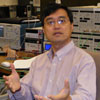THE ATLAS EXPERIMENT AT SMU
What is ATLAS?
ATLAS stands for "A Toroidal LHC Apparatus" and is one of four major experiments located on the Large Hadron Collider (LHC). It is the largest particle physics detector ever constructed, standing eight stories tall, with a length half that of a U.S. football field, and weighing in at over 7000 tons. It is designed to take 40 million pictures per second of proton-proton collisions delivered by the LHC. These collisions recreate conditions in the universe about a billionth of a second after the universe came into being - an event known as "The Big Bang". By studying these collisions, we are learning about the laws of physics and the constituents of the universe just a tiny fraction of a second after it appeared. By doing so, we hope to learn about the fundamental structure of energy, matter, space, and time so that we can better understand the universe as it was, as it is now, and as it will be in the future.
The videos in the above playlist will let you learn more about the ATLAS Experiment and the people that make it possible.
SMU ATLAS Contributions
The SMU group has a strong history of making major contributions to the ATLAS experimental physics program, with areas of concentration including the search for, discovery of, and now measurement of the Higgs Boson; searches for additional Higgs Bosons in nature and for other signs of "beyond-the-Standard Model" (BSM) physics, such as supersymmetry, extra dimensions, magnetic monopoles, and other unique signatures of new phenomena. We have made and continue to make important technical and maintenance contributions to the experiment, including in the Liquid Argon (LAr) calorimeter system and the ATLAS trigger and data acquisition system (TDAQ).
We continue to serve the technical and physics analysis needs of the ATLAS Experiment providing opportunities for students and post-doctoral researchers to become engaged in leading questions in the field. The SMU ATLAS group believes in training the next generation of particle physicist through experience with developing skills in hardware and software, and tackling difficult problems that lie at the heart of modern physics. For more about our research interests, see the next section.
For Run 2 of the LHC, our group is extremely focused on a few major areas of high priority to the experiment: Higgs physics, including H → bb, H → WW, H → ZZ; LAr Calorimeter and b-jet Trigger Maintenance and Operations; and LAr and Trigger upgrade work aimed at the Phase 1 and Phase 2 upgrade cycles of the experiment.
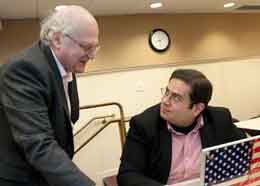
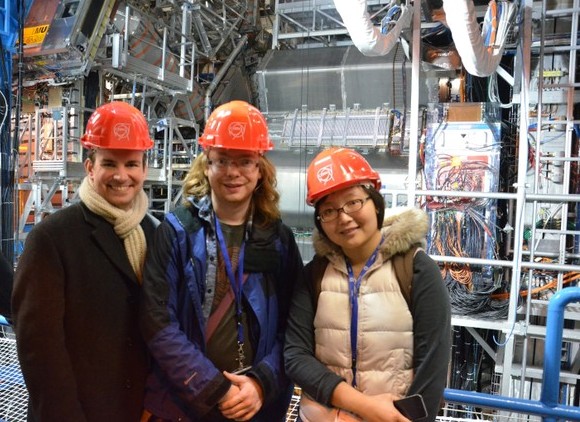
Research on ATLAS
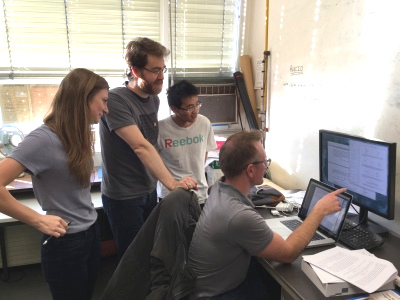
Graduate students work at CERN and partner in collaborations with post-doctoral researchers and faculty in our group, as well as researchers from across the globe.
SMU graduate students and post-doctoral researchers, as well as research faculty and tenured or tenure-track faculty, all play important roles in our research efforts on ATLAS. To learn more, contact the four faculty members in the SMU ATLAS group:
- Prof. Ryszard Stroynowski (Principal Investigator)
- Prof. Allison McCarn Deiana
- Prof. Robert Kehoe
- Prof. Stephen Sekula
- Prof. Jingbo Ye
Our physics contributions to ATLAS are nearly always associated with the PhD work of one or more graduate students, and the papers we select below map onto the work of our most recent successful PhD candidates. Some of our most recent contributions to physics research with ATLAS are listed below by topic.
Higgs Boson Discovery and Measurement
This includes the original discovery of the Higgs Boson using H0 → ZZ(*) → 4 leptons, H0 → γ γ, and H0 → W+W-; we have also subsequently used these final states to understand the quantum numbers of the particle, and helped confirm its identity as a Higgs Boson. We have also searched for other Standard Model Higgs Boson decay modes, including H 0 → Z0 γ
- Measurements of the Higgs boson production, fiducial and differential cross sections in the $4\ell$ decay channel at $\sqrt{s}=13~{\TeV}$ with the ATLAS detector. (2018, June 4). Retrieved from http://inspirehep.net/record/1676306
- Measurement of gluon fusion and vector boson fusion Higgs boson production cross-sections in the $H \to WW^{*} \to e\nu\mu\nu$ decay channel in pp collisions at $\sqrt{s} = 13$ TeV with the ATLAS detector. (2018, March 13). Retrieved from http://inspirehep.net/record/1662546
- "Study of the Higgs boson properties and search for high-mass scalar resonances in the $H \rightarrow ZZ^* \rightarrow 4\ell$ decay channel at $\sqrt{s}$ = 13 TeV with the ATLAS detector." ATLAS-CONF-2016-079 (2016).
- ATLAS Collaboration. (2014). Observation and measurement of Higgs boson decays to $WW^{\ast}$ with the ATLAS detector. Phys.Rev. D92 (2015) no.1, 012006
- ATLAS Collaboration. (2015). Determination of spin and parity of the Higgs boson in the $WW^\ast \to e \nu \mu \nu$ decay channel with the ATLAS detector. Eur.Phys.J. C75 (2015) no.5, 231
- "Evidence for the spin-0 nature of the Higgs boson using ATLAS data." ATLAS Collaboration. arXiv:1307:1432. Submitted for publication.
- "Search for the Standard Model Higgs boson in the H → Zγ decay mode with pp collisions at √s = 7 and 8 TeV". ATLAS Collaboration. ATLAS-CONF-2013-009
- "Observation of a New Particle in the Search for the Standard Model Higgs Boson with the ATLAS Detector at the LHC". ATLAS Collaboration. Phys.Lett. B716 (2012) 1-29.
Higgs Decays to Fermion Final States
This category encompasses our searches for the Standard Model Higgs boson decaying to fermions in the final state. This is a flagship measurement for the ongoing LHC Run 2 and a key prediction of the Standard Model. Fermion final states also play a key role in searches for two-Higgs production, a key signature of the Higgs boson's self-interaction. In addition, searches for H0→bb can be used for studies of physics scenarios beyond the Standard Model. Even more exotic final states (such as τν) can be used to search for new kinds of Higgs bosons.
- Evidence for the $H \rightarrow b\barb$ decay with the ATLAS detector. ATLAS-CONF-2017-041. (2017).
- Search for heavy resonances decaying to a $W$ or $Z$ boson and a Higgs boson in final states with leptons and $b$-jets in 36.1~fb$^-1$ of $pp$ collision data at $\sqrt s = 13$~\TeV\ with the ATLAS detector. ATLAS-CONF-2017-055.
- Search for Higgs boson pair production in the $b\bar{b}\gamma\gamma$ final state using pp collision data at $\sqrt{s}=13$ TeV with the ATLAS detector. ATLAS-CONF-2016-004. (2016).
- Aad, others (2015). [ATLAS] Search for charged Higgs bosons decaying via $H^\pm \rightarrow \tau^\pm\nu$ in fully hadronic final states using $pp$ collision data at $\sqrts = 8$ TeV with the ATLAS detector. JHEP 1503. pp. 088.
Exotic Physics Scenarios
These have included searches for di-boson resonances, which would be expected if there are new particles or extra spatial dimensions beyond the three already known dimensions; searches for magnetic monopoles, which if detected would explain the quantization of electric charge in nature.
- "Search for WZ resonances in the fully leptonic channel using pp collisions at sqrt(s) = 8 TeV with the ATLAS detector". ATLAS Collaboration. Phys. Lett. B (2014) pp. 223-243.
- "Search for diphoton events with large missing transverse momentum with 1 fb-1 of 7 TeV proton-proton collision data with the ATLAS detector". ATLAS Collaboration. PLB 710 (2012) 519
- "Search for magnetic monopoles in sqrt(s) = 7 TeV pp collisions with the ATLAS detector". ATLAS Collaboration. PRL 109 (2012) 261803.
Probing the Standard Model
The Standard Model is a very battle-tested model of nature, but that doesn't mean it has yielded all of its secrets, nor that it can withstand the next test of its predictions. In these papers, our group helped to dig deep into the Standard Model to assess its reliability as a description of nature.
- "Combination of searches for WW, WZ, and ZZ resonances in pp collisions at √s=8 TeV with the ATLAS detector". ATLAS Collaboration. Phys. Lett. B 755 (2016) 285-305
- "Measurements of Zγ and Zγγ production in pp collisions at √s= 8 TeV with the ATLAS detector". ATLAS Collaboration. Phys. Rev. D 93, 112002 (2016).
Current Group Members
Tenured or Tenure-Track Faculty
Research Associate Professors

Datao Gong

Andy Liu

Kent Liu
Research Assistant Professors

Katharine Leney
Post-doctoral Researchers

Alessandra Betti
Graduate Students
Matthew Feickert
Maddie McKay
Chris Milke
Peilong Wang
Undergraduate Students

Jared Burleson

Rebecca Moore
Historical Picture of SMU on ATLAS
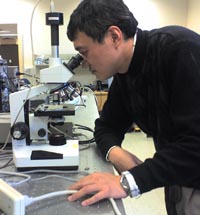 SMU physicists designed and built elements of readout electronics for the electromagnetic calorimeter system, including a 1600 channel optical link system
with
a total data rate of about 2.7 terabits per second. Before the turn-on of the experiment in 2009, most of our effort was devoted to the commissioning of the 220,000 detector channels and creation, validation, and deployment of control
software.
We have also been strongly involved in designing the software architecture to monitor the experiment in real-time.
SMU physicists designed and built elements of readout electronics for the electromagnetic calorimeter system, including a 1600 channel optical link system
with
a total data rate of about 2.7 terabits per second. Before the turn-on of the experiment in 2009, most of our effort was devoted to the commissioning of the 220,000 detector channels and creation, validation, and deployment of control
software.
We have also been strongly involved in designing the software architecture to monitor the experiment in real-time.
The R&D program for the future detector upgrade is pursued together with the Electrical Engineering Department to develop very fast opto-electronics components that can work in a very high radiation environment.











